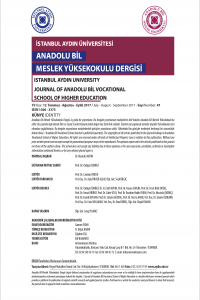Sürdürülebilir Kumaş Tasarımında Kompozisyon Ve Konstrüksiyon Farklılıklarının Kumaşın Fiziksel Özellikleri Üzerine Etkisi
Hızla büyüyen çevre sorunlarında önemli bir payı bulunan tekstil atıklarının yönetimi konusu her geçen gün önemini arttırmaktadır. Buna bağlı olarak da firmalar atıkların bertaraf edilmeden önce yeniden değerlendirilmesi, sürdürülebilir kumaş tasarımı ve üretimi konularında çalışmalar yapmaktadırlar. Küresel boyutta tüketicilerde artan sürdürülebilirlik bilinci de firmaların bu çalışmalara yönelmesinde etkili olmaktadır. Bu çalışmada, dokuma kumaş kompozisyonunda geri dönüştürülmüş iplik kullanımının ve bu kullanım miktarındaki (oranındaki) değişimlerin kumaşın fiziksel özellikleri üzerindeki etkileri incelenmiştir. Ayrıca; geri dönüştürülmüş ipliklerle kumaş üretiminde, farklı örgülerin kullanımının kumaşın fiziksel özellikleri üzerindeki etkileri de çalışmada araştırılan bir diğer konudur. Yapılan çalışmalar sonucunda, geri dönüşümlü iplikler ile sürdürülebilir kumaş üretiminde, tasarım aşamasında seçilecek örgü türlerinin, buna bağlı olarak oluşturulacak kumaş yapılarının ve iplik kompozisyonlarının geri dönüşümlü kumaş özelliklerinin iyileştirilmesi noktasında etkili olduğu ve bu tercihlerin doğru yapılması halinde kumaşların fiziksel özelliklerinin optimize edilebileceği sonucuna varılmıştır.
Anahtar Kelimeler:
Sürdürülebilirlik, Geri Dönüşüm, Kumaş Tasarımı
The Effect On The Physical Properties Of The Fabric In Differences Composition And Construction At Sustainable Fabric Design
The management of textile wastes, which has an important share in rapidly growing environmental problems, is increasing its importance day by day. In accordance with this, companies are working on re-evaluation of waste before disposal, sustainable fabric design and production. The increasing awareness of sustainability among consumers on a global scale is also effective in the orientation of companies to these studies. In this study, the effects of the use of recycled yarn in woven fabric composition and the changes in this amount (ratio) on the physical properties of the fabric were investigated. Also; In the production of fabric with recycled yarns, the effects of the use of different weaves on the physical properties of the fabric is another subject investigated in the study. As a result of the studies, it was concluded that in the production of sustainable fabrics along with recycled yarns, the knitting types to be selected at the design stage, the fabric structures and yarn compositions to be created accordingly are effective in improving the recyclable fabric properties, and if these choices are made correctly, the physical properties of the fabrics can be optimized.
Keywords:
Sustainability, Recycling, Fabric Design,
___
- Kurtoğlu Necef Ö., Seventekin N., Pamuk M. (2013) “A Study On Recycling The Fabric Scraps In Apparel Manufacturing Industry”, Tekstil ve Konfeksiyon Dergisi, 23 (3), S: 286-289
- Halimi T.M., Hassen B.M., Sakli F. (2008) “Cotton Waste Recycling: Quantitative and Qualitative Assesment”, Resource, Conservation and Rcycling, Vol:52, Issue:5, S:785-791
- Güngör A., Palamutçu S., İkiz Y. (2009) “Pamuklu Tekstiller Ve Çevre: Bir Bornozun Yaşam Döngü Değerlendirmesi”, Tekstil ve Konfeksiyon Dergisi, 3/2009, S:197-205
- Ütebay B., Çelik P., Çay A. (2019) “ Effects of Cotton Textile Waste Properties on Recycled Fibre Quality”, Journal of Cleaner Production, 222, S: 29-35, https://doi.org/10.1016/j.jclepro.2019.03.033
- Sandin G., Peters G.M. (2018) “ Environmental Impact of Textile Reuse abd Recycling – A Review”, Journal of Cleaner Production, Vol: 184, S: 353-365
- Zamanı B., Svanström M., Peters G., Rydberg T. (2014) “ A Carbon Footprint of Textile Recycling: A Case Study in Sweden”, Journal of Industrial Ecology, Vol:19, Issue: 4, S:676-687
- Pensuba N., Leu S.Y., Hu Y., Du C., Liu H., Jing H., Wang H., Lin C.S.K. (2017) “Recent Trends in Sustainable Textile Waste Recycling Methods: Current Situation and Future Prospects”, Topics in Current Chemistry, 375, 76
- Lindström K., Sjöblom T., Persson A., Kadi N. (2020) “Improving Mechanical Textile Recycling by Lubricant Pre-Treatment to Mitigate Length Loff of Fibers”, Sustainability, 12(20) : 8706
- Eser B., Çelik P., Çay A., Akgümüş D. (2016) “Tekstil ve Konfeksiyon Sektöründe Sürdürülebilirlik ve Geri Dönüşüm Olanakları”, Tekstil ve Mühendis, 23: 101, s:43-60
- https://www.cottonworks.com/topics/turkce/surdurulebilirlik/geri-donusturulmus-pamuk/ (Erişim Tarihi: 31 Ağustos 2021 15:30)
- ISO 16549:2021 - Textiles — Unevenness of Textile Strands — Capacitance method
- TS EN ISO 2062 - Tekstil - Paketlerden alınan iplikler - Tek ipliğin kopma kuvvetinin ve kopma anındaki uzamasının sabit hızlı uzama cihazı (CRE) kullanılarak tayini (ISO 2062:2009)
- TS EN ISO 12947- Tekstil - Martindale metoduyla kumaşların aşınmaya karşı dayanımının tayini
- ASTM D3512 - Standart Test Method for Pilling Resistance and Other Related Surface Changes of Textile Fabrics: Random Tumble Pilling Tester
- AATCC 61 - Test Method for Colorfastness to Laundering: Accelerated
- AATCC 15 - Test Method for Colorfastness to Perspiration
- AATCC 107 - Test Method for Colorfastness to Water
- AATCC 16 - Colorfastness to Light Standarts
- AATCC 8 - Test Method for Colorfastness to Crocking: Crockmeter
- AATCC 135 - Test Method for Dimensional Changes of Fabrics after Home Laundering
- ASTM D5034 - Standard Test Method for Breaking Strength and Elongation of Textile Fabrics
- ASTM D1424-21 Standard Test Method for Tearing Strength of Fabrics by Falling-Pendulum (Elmendorf-Type) Apparatus
- ASTM D3512 Standard Test Method for Pilling Resistance and Other Related Surface Changes of Textile Fabrics: Random Tumble Pilling Tester
- ISSN: 1306-3375
- Başlangıç: 2006
- Yayıncı: İstanbul Aydın Üniversitesi
Sayıdaki Diğer Makaleler
Enerji etkin yapı tasarımı ve parametrelerinin RIBA çalışma planı ile değerlendirilmesi
Sevilay ÖZDEMİR, Şensin YAĞMUR
Mekân tasarımlarında kullanılan yönlendirme levhaları üzerine inceleme
Fatma DURMUŞ AKBAL, Bekir AKBAL
Sinem BUDUN GÜLAS, Ayçin ASMA, Vedat ÖZYAZGAN, Sertan GÜLAL
Makine öğrenmesi algoritmalarıyla kalp hastalıklarının tespit edilmesine yönelik performans analizi
